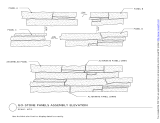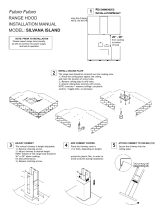
PLEASE READ COMPLETE INSTRUCTIONS BEFORE PROCEEDING.
INSTALLATION MUST COMPLY WITH ALL LOCAL CODES.
IMPORTANT: Save these instructions for the local electrical inspector’s use.
INSTALLER: Please leave these instructions with this unit for the owner.
OWNER: Please retain the instructions for future reference.
SAFETY WARNING: Turn power circuit OFF at the service panel and lock panel door before
wiring this unit.
IMPORTANT SAFETY INSTRUCTIONS
CAUTION – To reduce the
risk of a rangetop grease fire.
1. Never leave cooktop surface
unattended while on high
setting
2. Boil overs cause smoke and
greasy spillovers may ignite.
Heat oils slowly on low or
medium settings.
3. Hood fan should always be
ON when cooking on high
heat or when flambeing
foods (i.e. Crepes Suzette,
Cherries Jubilee, Peppercorn
Beef Flambe.)
4. Clean in-hood fans
frequently. Do not allow
grease to accumulate on fan
or baffle filters.
5. Always use cookware
appropriate for the size of the
surface element.
CAUTION – To reduce the
risk of fire, electric shock, or
injury to people, observe the
following:
1. Use this rangehood only in
the manner intended by the
manufacturer. If you have
any questions, contact the
manufacturer – Prizer
Hoods.
2. Before servicing or cleaning
the unit, switch power off at
service panel and lock the
panel to prevent the power
from being switched on
accidentally. When switched
off for service, attach a tag to
the service panel to indicate
power has been switched off
for maintenance.
3. Install this rangehood only
with remote fan models rated
maximum 12.8A or in-hood
fans manufacturered by
Prizer Hoods, CFM300,
CFM600, CFM1200.
CAUTION – To reduce the
risk of injury to people, in the
event of a rangetop grease fire,
observe the following:
1. SMOTHER FLAMES with a
tight fitting lid, cookie sheet
or other metal tray.
Immediately turn the gas
burner OFF. NEVER USE
WATER, wet dish-cloths or
towels as a violent steam
explosion will occur.
2. PREVENT BURNS. If gas
flames do not extinguish
immediately: EVACUATE
AND CALL THE FIRE
DEPARTMENT.
3. NEVER PICK UP A
FLAMING PAN as you may
sustain burns.
4. Use fire extinguisher only if:
• You know you have a class
ABC extinguisher, and you
know how to operate it.
• Fire is small & contained in
the area where it started.
• Fire department is being
called.
• You can fight the fire with
your back to an exit.
CAUTION: FOR GENERAL VENTILATION
USE ONLY. DO NOT USE TO EXHAUST
HAZARDOUS OR EXPLOSIVE MATERIALS
OR VAPOR.
HOOD SHAPES & DIMENSIONS CAN VARY
WITHOUT NOTIFICATION. NO HARDWARE
IS SUPPLIED FOR INSTALLATION
3























